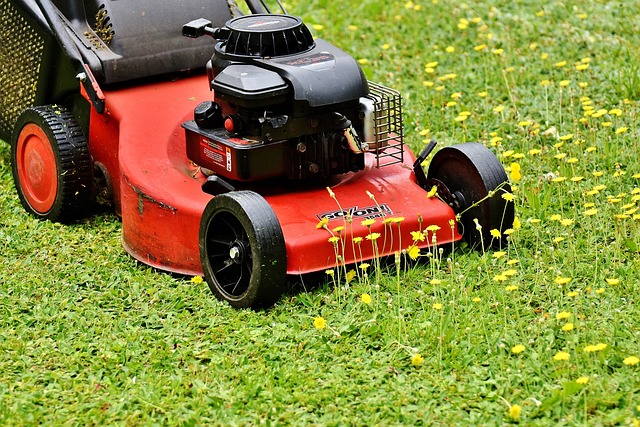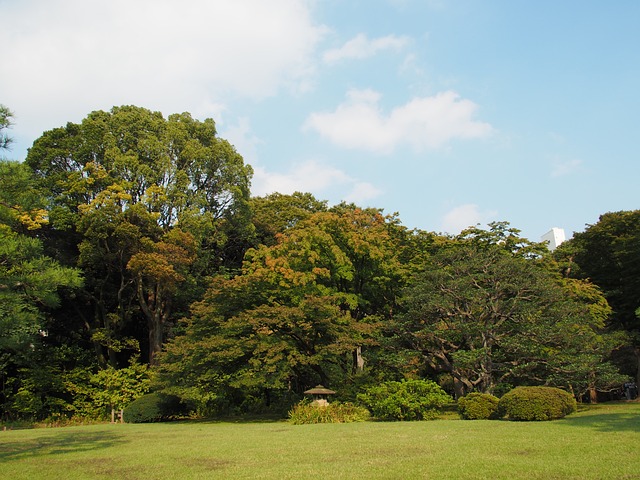Lawn Care and Landscaping are essential for maintaining a healthy, vibrant lawn that stands out in any neighborhood. A successful approach involves tailoring a regimen to local environmental conditions, with key practices such as optimizing mowing height between 2 to 4 inches, precise fertilization, timely aeration, and efficient irrigation systems to conserve water while promoting growth. Strategic landscaping design incorporates suitable grass varieties, light exposure optimization, and eco-friendly practices that support sustainability and biodiversity. Regular soil testing informs effective fertilization and pest management strategies that minimize environmental impact. Seasonal lawn care adjustments are necessary to handle different weather conditions, with proactive monitoring of soil health, moisture levels, and the implementation of integrated pest management techniques to prevent and manage issues effectively. By combining these practices with a year-round tailored maintenance plan, Lawn Care and Landscaping professionals can ensure a lush, resilient lawn that is both aesthetically pleasing and environmentally responsible.
Explore the art of maintaining a lush, resilient lawn with our comprehensive guide on Lawn Care and Strategic Landscaping. Delve into Mastering Lawn Care techniques that breathe life into your turf, understand Design Principles that optimize its management in our next section, and uncover Advanced Turf Maintenance strategies tailored to the seasons and their challenges. This article is a one-stop resource for achieving and sustaining turf excellence.
- Mastering Lawn Care: Essential Techniques for a Vibrant Turf
- Strategic Landscaping: Design Principles for Optimal Turf Management
- Advanced Turf Maintenance: Seasonal Care and Problem-Solving Approaches
Mastering Lawn Care: Essential Techniques for a Vibrant Turf

Engaging in meticulous lawn care and landscaping practices is key to achieving a lush, vibrant turf that stands out in any neighborhood. A robust turf management regimen encompasses a variety of techniques tailored to the specific conditions of your local environment. Proper mowing, for instance, involves cutting the grass at an optimal height, which typically ranges from 2 to 4 inches, depending on the grass type and climate. This practice not only enhances the turf’s resilience against weeds and diseases but also encourages a healthy root system.
In addition to mowing, fertilization plays a pivotal role in lawn care and landscaping. Selecting the right type of fertilizer, timing its application according to the growth patterns of your grass, and understanding the nutritional needs of your turf are all critical factors for maintaining a thriving landscape. Aeration is another essential technique that allows air, water, and nutrients to reach the grass roots, improving soil health and promoting strong, deep root growth. Irrigation systems should be optimized to deliver water efficiently without causing runoff or overwatering, conserving water while ensuring your turf receives the hydration it needs to thrive. By integrating these techniques into a comprehensive lawn care and landscaping plan, you can achieve a turf that is not only aesthetically pleasing but also environmentally sustainable and resilient against various environmental challenges.
Strategic Landscaping: Design Principles for Optimal Turf Management

Effective turf management is a cornerstone of strategic landscaping, ensuring that lawns and outdoor spaces thrive under various conditions. To achieve this, landscape architects and turf professionals must consider several design principles that prioritize both aesthetics and functionality. These principles include selecting the right grass varieties for local soil types and climate, optimizing sunlight exposure, and implementing a smart irrigation system to maintain consistent moisture levels. The choice of equipment, from mowers to aerators, should be tailored to the size and type of turf to facilitate efficient maintenance. Additionally, integrating native plants and ground covers into the design can reduce maintenance demands while enhancing biodiversity and resilience. By adhering to these strategic design principles, landscapers can create visually appealing, sustainable, and easily manageable lawns that serve as a focal point in any landscaping project.
Incorporating eco-friendly practices into turf management not only promotes environmental stewardship but also contributes to cost-effectiveness and longevity. Lawn Care and Landscaping experts emphasize the importance of regular soil testing, which provides insights into nutrient deficiencies or imbalances that can affect grass health. A proactive approach to pest and disease management protects the turf from harmful organisms while minimizing the need for chemical treatments. Moreover, strategic mowing patterns and heights can encourage dense turf growth, crowd out weeds, and reduce the likelihood of soil compaction. By leveraging these advanced techniques and technologies in lawn care and landscaping, professionals can design and maintain outdoor spaces that are both beautiful and sustainable.
Advanced Turf Maintenance: Seasonal Care and Problem-Solving Approaches

Maintaining a lush, healthy lawn requires year-round attention and a strategic approach to care that adapts to seasonal changes and potential issues. Expert turf management encompasses a deep understanding of local climate conditions, soil types, and grass species, ensuring that lawn care and landscaping practices are tailored to the unique needs of the turf. Throughout the year, lawns face distinct challenges such as heat stress during summer months, cold tolerance in winter, and pest infestations or disease outbreaks at any time. Seasonal care strategies are thus vital for preparing the turf for each season’s particular demands. This includes adjusting irrigation schedules, selecting appropriate fertilizers, overseeding for thicker coverage, and implementing integrated pest management (IPM) practices to address problematic insects or weeds effectively.
Moreover, problem-solving in turf maintenance is a dynamic process that requires both proactive and reactive measures. Proactively, lawn care professionals employ advanced diagnostic tools and techniques to monitor soil health, moisture levels, and the overall condition of the turf. This vigilance allows for early detection and treatment of issues before they escalate. Reactive strategies come into play when problems arise, such as addressing brown patches, managing thatch accumulation, or recovering from extreme weather events. By combining preventative care with swift problem-solving, turf management experts ensure that lawns remain resilient and vibrant throughout the year, providing homeowners and landscape professionals with aesthetically pleasing outdoor spaces that are both functional and sustainable.
In conclusion, mastering lawn care through essential techniques and strategic landscaping design principles is crucial for maintaining a vibrant turf. Advanced turf maintenance, which includes seasonal care and proactive problem-solving, further enhances the health and appearance of your lawn. By integrating these practices, you can achieve an optimal turf management system that not only elevates your outdoor spaces but also contributes to the overall aesthetic of your property. Lawn Care and Landscaping are integral components in this endeavor, ensuring a lush, resilient, and visually pleasing landscape all year round.
